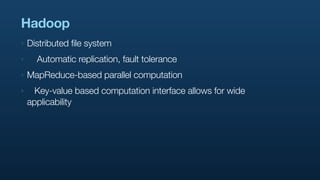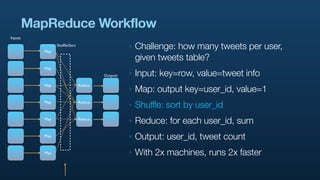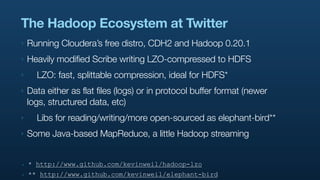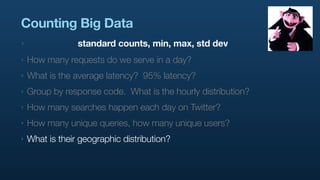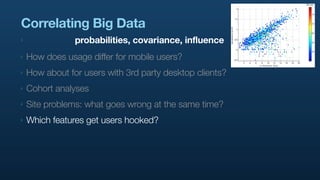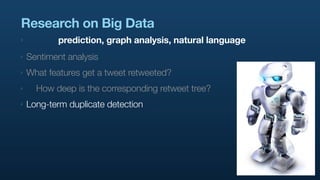Ad
NoSQL at Twitter (NoSQL EU 2010)
- 1. NoSQL at Twitter Kevin Weil -- @kevinweil Analytics Lead, Twitter April 21, 2010 TM
- 2. Introduction ‣ How We Arrived at NoSQL: A Crash Course ‣ Collecting Data (Scribe) ‣ Storing and Analyzing Data (Hadoop) ‣ Rapid Learning over Big Data (Pig) ‣ And More: Cassandra, HBase, FlockDB
- 3. My Background ‣ Studied Mathematics and Physics at Harvard, Physics at Stanford ‣ Tropos Networks (city-wide wireless): mesh routing algorithms, GBs of data ‣ Cooliris (web media): Hadoop and Pig for analytics, TBs of data ‣ Twitter: Hadoop, Pig, HBase, Cassandra, machine learning, visualization, social graph analysis, soon to be PBs data
- 4. Introduction ‣ How We Arrived at NoSQL: A Crash Course ‣ Collecting Data (Scribe) ‣ Storing and Analyzing Data (Hadoop) ‣ Rapid Learning over Big Data (Pig) ‣ And More: Cassandra, HBase, FlockDB
- 5. Data, Data Everywhere ‣ Twitter users generate a lot of data ‣ Anybody want to guess?
- 6. Data, Data Everywhere ‣ Twitter users generate a lot of data ‣ Anybody want to guess? ‣ 7 TB/day (2+ PB/yr)
- 7. Data, Data Everywhere ‣ Twitter users generate a lot of data ‣ Anybody want to guess? ‣ 7 TB/day (2+ PB/yr) ‣ 10,000 CDs/day
- 8. Data, Data Everywhere ‣ Twitter users generate a lot of data ‣ Anybody want to guess? ‣ 7 TB/day (2+ PB/yr) ‣ 10,000 CDs/day ‣ 5 million floppy disks
- 9. Data, Data Everywhere ‣ Twitter users generate a lot of data ‣ Anybody want to guess? ‣ 7 TB/day (2+ PB/yr) ‣ 10,000 CDs/day ‣ 5 million floppy disks ‣ 300 GB while I give this talk
- 10. Data, Data Everywhere ‣ Twitter users generate a lot of data ‣ Anybody want to guess? ‣ 7 TB/day (2+ PB/yr) ‣ 10,000 CDs/day ‣ 5 million floppy disks ‣ 300 GB while I give this talk ‣ And doubling multiple times per year
- 11. Syslog? ‣ Started with syslog-ng ‣ As our volume grew, it didn’t scale
- 12. Syslog? ‣ Started with syslog-ng ‣ As our volume grew, it didn’t scale ‣ Resources overwhelmed ‣ Lost data
- 13. Scribe ‣ Surprise! FB had same problem, built and open-sourced Scribe ‣ Log collection framework over Thrift ‣ You write log lines, with categories ‣ It does the rest
- 14. Scribe ‣ Runs locally; reliable in network outage FE FE FE
- 15. Scribe ‣ Runs locally; reliable in network outage ‣ Nodes only know downstream FE FE FE writer; hierarchical, scalable Agg Agg
- 16. Scribe ‣ Runs locally; reliable in network outage ‣ Nodes only know downstream FE FE FE writer; hierarchical, scalable ‣ Pluggable outputs Agg Agg File HDFS
- 17. Scribe at Twitter ‣ Solved our problem, opened new vistas ‣ Currently 30 different categories logged from multiple sources ‣ FE: Javascript, Ruby on Rails ‣ Middle tier: Ruby on Rails, Scala ‣ Backend: Scala, Java, C++
- 18. Scribe at Twitter ‣ We’ve contributed to it as we’ve used it ‣ Improved logging, monitoring, writing to HDFS, compression ‣ Continuing to work with FB on patches ‣ GSoC project! Help make it more awesome. • http://github.com/traviscrawford/scribe • http://wiki.developers.facebook.com/index.php/User:GSoC
- 19. Introduction ‣ How We Arrived at NoSQL: A Crash Course ‣ Collecting Data (Scribe) ‣ Storing and Analyzing Data (Hadoop) ‣ Rapid Learning over Big Data (Pig) ‣ And More: Cassandra, HBase, FlockDB
- 20. How do you store 7TB/day? ‣ Single machine? ‣ What’s HD write speed?
- 21. How do you store 7TB/day? ‣ Single machine? ‣ What’s HD write speed? ‣ ~80 MB/s
- 22. How do you store 7TB/day? ‣ Single machine? ‣ What’s HD write speed? ‣ ~80 MB/s ‣ 24.3 hours to write 7 TB
- 23. How do you store 7TB/day? ‣ Single machine? ‣ What’s HD write speed? ‣ ~80 MB/s ‣ 24.3 hours to write 7 TB ‣ Uh oh.
- 24. Where do I put 7TB/day? ‣ Need a cluster of machines
- 25. Where do I put 7TB/day? ‣ Need a cluster of machines ‣ ... which adds new layers of complexity
- 26. Hadoop ‣ Distributed file system ‣ Automatic replication, fault tolerance
- 27. Hadoop ‣ Distributed file system ‣ Automatic replication, fault tolerance ‣ MapReduce-based parallel computation ‣ Key-value based computation interface allows for wide applicability
- 28. Hadoop ‣ Open source: top-level Apache project ‣ Scalable: Y! has a 4000 node cluster ‣ Powerful: sorted 1TB of random integers in 62 seconds ‣ Easy packaging: free Cloudera RPMs
- 29. MapReduce Workflow Inputs Map Shuffle/Sort ‣ Challenge: how many tweets per user, given tweets table? Map Outputs ‣ Input: key=row, value=tweet info Map Reduce ‣ Map: output key=user_id, value=1 Map Reduce ‣ Shuffle: sort by user_id Map Reduce ‣ Reduce: for each user_id, sum Map ‣ Output: user_id, tweet count Map ‣ With 2x machines, runs 2x faster
- 30. MapReduce Workflow Inputs Map Shuffle/Sort ‣ Challenge: how many tweets per user, given tweets table? Map Outputs ‣ Input: key=row, value=tweet info Map Reduce ‣ Map: output key=user_id, value=1 Map Reduce ‣ Shuffle: sort by user_id Map Reduce ‣ Reduce: for each user_id, sum Map ‣ Output: user_id, tweet count Map ‣ With 2x machines, runs 2x faster
- 31. MapReduce Workflow Inputs Map Shuffle/Sort ‣ Challenge: how many tweets per user, given tweets table? Map Outputs ‣ Input: key=row, value=tweet info Map Reduce ‣ Map: output key=user_id, value=1 Map Reduce ‣ Shuffle: sort by user_id Map Reduce ‣ Reduce: for each user_id, sum Map ‣ Output: user_id, tweet count Map ‣ With 2x machines, runs 2x faster
- 32. MapReduce Workflow Inputs Map Shuffle/Sort ‣ Challenge: how many tweets per user, given tweets table? Map Outputs ‣ Input: key=row, value=tweet info Map Reduce ‣ Map: output key=user_id, value=1 Map Reduce ‣ Shuffle: sort by user_id Map Reduce ‣ Reduce: for each user_id, sum Map ‣ Output: user_id, tweet count Map ‣ With 2x machines, runs 2x faster
- 33. MapReduce Workflow Inputs Map Shuffle/Sort ‣ Challenge: how many tweets per user, given tweets table? Map Outputs ‣ Input: key=row, value=tweet info Map Reduce ‣ Map: output key=user_id, value=1 Map Reduce ‣ Shuffle: sort by user_id Map Reduce ‣ Reduce: for each user_id, sum Map ‣ Output: user_id, tweet count Map ‣ With 2x machines, runs 2x faster
- 34. MapReduce Workflow Inputs Map Shuffle/Sort ‣ Challenge: how many tweets per user, given tweets table? Map Outputs ‣ Input: key=row, value=tweet info Map Reduce ‣ Map: output key=user_id, value=1 Map Reduce ‣ Shuffle: sort by user_id Map Reduce ‣ Reduce: for each user_id, sum Map ‣ Output: user_id, tweet count Map ‣ With 2x machines, runs 2x faster
- 35. MapReduce Workflow Inputs Map Shuffle/Sort ‣ Challenge: how many tweets per user, given tweets table? Map Outputs ‣ Input: key=row, value=tweet info Map Reduce ‣ Map: output key=user_id, value=1 Map Reduce ‣ Shuffle: sort by user_id Map Reduce ‣ Reduce: for each user_id, sum Map ‣ Output: user_id, tweet count Map ‣ With 2x machines, runs 2x faster
- 36. Two Analysis Challenges ‣ 1. Compute friendships in Twitter’s social graph ‣ grep, awk? No way. ‣ Data is in MySQL... self join on an n-billion row table? ‣ n,000,000,000 x n,000,000,000 = ?
- 37. Two Analysis Challenges ‣ 1. Compute friendships in Twitter’s social graph ‣ grep, awk? No way. ‣ Data is in MySQL... self join on an n-billion row table? ‣ n,000,000,000 x n,000,000,000 = ? ‣ I don’t know either.
- 38. Two Analysis Challenges ‣ 2. Large-scale grouping and counting? ‣ select count(*) from users? Maybe... ‣ select count(*) from tweets? Uh... ‣ Imagine joining them... ‣ ... and grouping... ‣ ... and sorting...
- 39. Back to Hadoop ‣ Didn’t we have a cluster of machines?
- 40. Back to Hadoop ‣ Didn’t we have a cluster of machines?
- 41. Back to Hadoop ‣ Didn’t we have a cluster of machines? ‣ Hadoop makes it easy to distribute the calculation ‣ Purpose-built for parallel computation ‣ Just a slight mindset adjustment
- 42. Back to Hadoop ‣ Didn’t we have a cluster of machines? ‣ Hadoop makes it easy to distribute the calculation ‣ Purpose-built for parallel computation ‣ Just a slight mindset adjustment ‣ But a fun and valuable one!
- 43. Analysis at scale ‣ Now we’re rolling ‣ Count all tweets: 12 billion, 5 minutes ‣ Hit FlockDB in parallel to assemble social graph aggregates ‣ Run pagerank across users to calculate reputations
- 44. But... ‣ Analysis typically in Java ‣ “I need less Java in my life, not more.”
- 45. But... ‣ Analysis typically in Java ‣ “I need less Java in my life, not more.” ‣ Single-input, two-stage data flow is rigid
- 46. But... ‣ Analysis typically in Java ‣ “I need less Java in my life, not more.” ‣ Single-input, two-stage data flow is rigid ‣ Projections, filters: custom code
- 47. But... ‣ Analysis typically in Java ‣ “I need less Java in my life, not more.” ‣ Single-input, two-stage data flow is rigid ‣ Projections, filters: custom code ‣ Joins are lengthy, error-prone
- 48. But... ‣ Analysis typically in Java ‣ “I need less Java in my life, not more.” ‣ Single-input, two-stage data flow is rigid ‣ Projections, filters: custom code ‣ Joins are lengthy, error-prone ‣ n-stage jobs hard to manage
- 49. But... ‣ Analysis typically in Java ‣ “I need less Java in my life, not more.” ‣ Single-input, two-stage data flow is rigid ‣ Projections, filters: custom code ‣ Joins are lengthy, error-prone ‣ n-stage jobs hard to manage ‣ Exploration requires compilation!
- 50. Introduction ‣ How We Arrived at NoSQL: A Crash Course ‣ Collecting Data (Scribe) ‣ Storing and Analyzing Data (Hadoop) ‣ Rapid Learning over Big Data (Pig) ‣ And More: Cassandra, HBase, FlockDB
- 51. Pig ‣ High-level language ‣ Transformations on sets of records ‣ Process data one step at a time ‣ Easier than SQL?
- 52. Why Pig? ‣ Because I bet you can read the following script.
- 53. A Real Pig Script
- 54. A Real Pig Script ‣ Now, just for fun... the same calculation in vanilla Hadoop MapReduce.
- 55. No, seriously.
- 56. Pig Democratizes Large-scale Data Analysis ‣ The Pig version is: ‣ 5% of the code
- 57. Pig Democratizes Large-scale Data Analysis ‣ The Pig version is: ‣ 5% of the code ‣ 5% of the time
- 58. Pig Democratizes Large-scale Data Analysis ‣ The Pig version is: ‣ 5% of the code ‣ 5% of the time ‣ Within 25% of the execution time
- 59. One Thing I’ve Learned ‣ It’s easy to answer questions ‣ It’s hard to ask the right questions
- 60. One Thing I’ve Learned ‣ It’s easy to answer questions ‣ It’s hard to ask the right questions ‣ Value the system that promotes innovation, iteration
- 61. One Thing I’ve Learned ‣ It’s easy to answer questions ‣ It’s hard to ask the right questions ‣ Value the system that promotes innovation, iteration ‣ More minds contributing = more value from your data
- 62. The Hadoop Ecosystem at Twitter ‣ Running Cloudera’s free distro, CDH2 and Hadoop 0.20.1
- 63. The Hadoop Ecosystem at Twitter ‣ Running Cloudera’s free distro, CDH2 and Hadoop 0.20.1 ‣ Heavily modified Scribe writing LZO-compressed to HDFS ‣ LZO: fast, splittable compression, ideal for HDFS* ‣ * http://www.github.com/kevinweil/hadoop-lzo ‣
- 64. The Hadoop Ecosystem at Twitter ‣ Running Cloudera’s free distro, CDH2 and Hadoop 0.20.1 ‣ Heavily modified Scribe writing LZO-compressed to HDFS ‣ LZO: fast, splittable compression, ideal for HDFS* ‣ Data either as flat files (logs) or in protocol buffer format (newer logs, structured data, etc) ‣ Libs for reading/writing/more open-sourced as elephant-bird** ‣ * http://www.github.com/kevinweil/hadoop-lzo ‣ ** http://www.github.com/kevinweil/elephant-bird
- 65. The Hadoop Ecosystem at Twitter ‣ Running Cloudera’s free distro, CDH2 and Hadoop 0.20.1 ‣ Heavily modified Scribe writing LZO-compressed to HDFS ‣ LZO: fast, splittable compression, ideal for HDFS* ‣ Data either as flat files (logs) or in protocol buffer format (newer logs, structured data, etc) ‣ Libs for reading/writing/more open-sourced as elephant-bird** ‣ Some Java-based MapReduce, a little Hadoop streaming ‣ * http://www.github.com/kevinweil/hadoop-lzo ‣ ** http://www.github.com/kevinweil/elephant-bird
- 66. The Hadoop Ecosystem at Twitter ‣ Running Cloudera’s free distro, CDH2 and Hadoop 0.20.1 ‣ Heavily modified Scribe writing LZO-compressed to HDFS ‣ LZO: fast, splittable compression, ideal for HDFS* ‣ Data either as flat files (logs) or in protocol buffer format (newer logs, structured data, etc) ‣ Libs for reading/writing/more open-sourced as elephant-bird** ‣ Some Java-based MapReduce, some HBase, Hadoop streaming ‣ Most analysis, and most interesting analyses, done in Pig ‣ * http://www.github.com/kevinweil/hadoop-lzo ‣ ** http://www.github.com/kevinweil/elephant-bird
- 67. Data? ‣ Semi-structured: apache logs (search, .com, mobile), search query logs, RoR logs, mysql query logs, A/B testing logs, signup flow logging, and on...
- 68. Data? ‣ Semi-structured: apache logs (search, .com, mobile), search query logs, RoR logs, mysql query logs, A/B testing logs, signup flow logging, and on... ‣ Structured: tweets, users, blocks, phones, favorites, saved searches, retweets, geo, authentications, sms, 3rd party clients, followings
- 69. Data? ‣ Semi-structured: apache logs (search, .com, mobile), search query logs, RoR logs, mysql query logs, A/B testing logs, signup flow logging, and on... ‣ Structured: tweets, users, blocks, phones, favorites, saved searches, retweets, geo, authentications, sms, 3rd party clients, followings ‣ Entangled: the social graph
- 70. So what do we do with it?
- 71. Counting Big Data ‣ standard counts, min, max, std dev ‣ How many requests do we serve in a day?
- 72. Counting Big Data ‣ standard counts, min, max, std dev ‣ How many requests do we serve in a day? ‣ What is the average latency? 95% latency? ‣
- 73. Counting Big Data ‣ standard counts, min, max, std dev ‣ How many requests do we serve in a day? ‣ What is the average latency? 95% latency? ‣ Group by response code. What is the hourly distribution? ‣
- 74. Counting Big Data ‣ standard counts, min, max, std dev ‣ How many requests do we serve in a day? ‣ What is the average latency? 95% latency? ‣ Group by response code. What is the hourly distribution? ‣ How many searches happen each day on Twitter? ‣
- 75. Counting Big Data ‣ standard counts, min, max, std dev ‣ How many requests do we serve in a day? ‣ What is the average latency? 95% latency? ‣ Group by response code. What is the hourly distribution? ‣ How many searches happen each day on Twitter? ‣ How many unique queries, how many unique users? ‣
- 76. Counting Big Data ‣ standard counts, min, max, std dev ‣ How many requests do we serve in a day? ‣ What is the average latency? 95% latency? ‣ Group by response code. What is the hourly distribution? ‣ How many searches happen each day on Twitter? ‣ How many unique queries, how many unique users? ‣ What is their geographic distribution?
- 77. Counting Big Data ‣ Where are users querying from? The API, the front page, their profile page, etc? ‣
- 78. Correlating Big Data ‣ probabilities, covariance, influence ‣ How does usage differ for mobile users?
- 79. Correlating Big Data ‣ probabilities, covariance, influence ‣ How does usage differ for mobile users? ‣ How about for users with 3rd party desktop clients?
- 80. Correlating Big Data ‣ probabilities, covariance, influence ‣ How does usage differ for mobile users? ‣ How about for users with 3rd party desktop clients? ‣ Cohort analyses
- 81. Correlating Big Data ‣ probabilities, covariance, influence ‣ How does usage differ for mobile users? ‣ How about for users with 3rd party desktop clients? ‣ Cohort analyses ‣ Site problems: what goes wrong at the same time?
- 82. Correlating Big Data ‣ probabilities, covariance, influence ‣ How does usage differ for mobile users? ‣ How about for users with 3rd party desktop clients? ‣ Cohort analyses ‣ Site problems: what goes wrong at the same time? ‣ Which features get users hooked?
- 83. Correlating Big Data ‣ probabilities, covariance, influence ‣ How does usage differ for mobile users? ‣ How about for users with 3rd party desktop clients? ‣ Cohort analyses ‣ Site problems: what goes wrong at the same time? ‣ Which features get users hooked? ‣ Which features do successful users use often?
- 84. Correlating Big Data ‣ probabilities, covariance, influence ‣ How does usage differ for mobile users? ‣ How about for users with 3rd party desktop clients? ‣ Cohort analyses ‣ Site problems: what goes wrong at the same time? ‣ Which features get users hooked? ‣ Which features do successful users use often? ‣ Search corrections, search suggestions
- 85. Correlating Big Data ‣ probabilities, covariance, influence ‣ How does usage differ for mobile users? ‣ How about for users with 3rd party desktop clients? ‣ Cohort analyses ‣ Site problems: what goes wrong at the same time? ‣ Which features get users hooked? ‣ Which features do successful users use often? ‣ Search corrections, search suggestions ‣ A/B testing
- 86. Correlating Big Data ‣ What is the correlation between users with registered phones and users that tweet?
- 87. Research on Big Data ‣ prediction, graph analysis, natural language ‣ What can we tell about a user from their tweets?
- 88. Research on Big Data ‣ prediction, graph analysis, natural language ‣ What can we tell about a user from their tweets? ‣ From the tweets of those they follow?
- 89. Research on Big Data ‣ prediction, graph analysis, natural language ‣ What can we tell about a user from their tweets? ‣ From the tweets of those they follow? ‣ From the tweets of their followers?
- 90. Research on Big Data ‣ prediction, graph analysis, natural language ‣ What can we tell about a user from their tweets? ‣ From the tweets of those they follow? ‣ From the tweets of their followers? ‣ From the ratio of followers/following?
- 91. Research on Big Data ‣ prediction, graph analysis, natural language ‣ What can we tell about a user from their tweets? ‣ From the tweets of those they follow? ‣ From the tweets of their followers? ‣ From the ratio of followers/following? ‣ What graph structures lead to successful networks?
- 92. Research on Big Data ‣ prediction, graph analysis, natural language ‣ What can we tell about a user from their tweets? ‣ From the tweets of those they follow? ‣ From the tweets of their followers? ‣ From the ratio of followers/following? ‣ What graph structures lead to successful networks? ‣ User reputation
- 93. Research on Big Data ‣ prediction, graph analysis, natural language ‣ Sentiment analysis
- 94. Research on Big Data ‣ prediction, graph analysis, natural language ‣ Sentiment analysis ‣ What features get a tweet retweeted?
- 95. Research on Big Data ‣ prediction, graph analysis, natural language ‣ Sentiment analysis ‣ What features get a tweet retweeted? ‣ How deep is the corresponding retweet tree?
- 96. Research on Big Data ‣ prediction, graph analysis, natural language ‣ Sentiment analysis ‣ What features get a tweet retweeted? ‣ How deep is the corresponding retweet tree? ‣ Long-term duplicate detection
- 97. Research on Big Data ‣ prediction, graph analysis, natural language ‣ Sentiment analysis ‣ What features get a tweet retweeted? ‣ How deep is the corresponding retweet tree? ‣ Long-term duplicate detection ‣ Machine learning
- 98. Research on Big Data ‣ prediction, graph analysis, natural language ‣ Sentiment analysis ‣ What features get a tweet retweeted? ‣ How deep is the corresponding retweet tree? ‣ Long-term duplicate detection ‣ Machine learning ‣ Language detection
- 99. Research on Big Data ‣ prediction, graph analysis, natural language ‣ Sentiment analysis ‣ What features get a tweet retweeted? ‣ How deep is the corresponding retweet tree? ‣ Long-term duplicate detection ‣ Machine learning ‣ Language detection ‣ ... the list goes on.
- 100. Research on Big Data ‣ How well can we detect bots and other non-human tweeters?
- 101. Introduction ‣ How We Arrived at NoSQL: A Crash Course ‣ Collecting Data (Scribe) ‣ Storing and Analyzing Data (Hadoop) ‣ Rapid Learning over Big Data (Pig) ‣ And More: Cassandra, HBase, FlockDB
- 102. HBase ‣ BigTable clone on top of HDFS ‣ Distributed, column-oriented, no datatypes ‣ Unlike the rest of HDFS, designed for low-latency ‣ Importantly, data is mutable
- 103. HBase at Twitter ‣ We began building real products based on Hadoop ‣ People search
- 104. HBase at Twitter ‣ We began building real products based on Hadoop ‣ People search ‣ Old version: offline process on a single node
- 105. HBase at Twitter ‣ We began building real products based on Hadoop ‣ People search ‣ Old version: offline process on a single node ‣ New version: complex user calculations, hit extra services in real time, custom indexing
- 106. HBase at Twitter ‣ We began building real products based on Hadoop ‣ People search ‣ Old version: offline process on a single node ‣ New version: complex user calculations, hit extra services in real time, custom indexing ‣ Underlying data is mutable ‣ Mutable layer on top of HDFS --> HBase
- 107. People Search ‣ Import user data into HBase
- 108. People Search ‣ Import user data into HBase ‣ Periodic MapReduce job reading from HBase ‣ Hits FlockDB, multiple other internal services in mapper ‣ Custom partitioning
- 109. People Search ‣ Import user data into HBase ‣ Periodic MapReduce job reading from HBase ‣ Hits FlockDB, multiple other internal services in mapper ‣ Custom partitioning ‣ Data sucked across to sharded, replicated, horizontally scalable, in-memory, low-latency Scala service ‣ Build a trie, do case folding/normalization, suggestions, etc
- 110. People Search ‣ Import user data into HBase ‣ Periodic MapReduce job reading from HBase ‣ Hits FlockDB, multiple other internal services in mapper ‣ Custom partitioning ‣ Data sucked across to sharded, replicated, horizontally scalable, in-memory, low-latency Scala service ‣ Build a trie, do case folding/normalization, suggestions, etc ‣ See http://www.slideshare.net/al3x/building-distributed-systems- in-scala for more
- 111. HBase ‣ More products now being built on top of it ‣ Flexible, easy to connect to MapReduce/Pig
- 112. HBase vs Cassandra ‣ “Their origins reveal their strengths and weaknesses”
- 113. HBase vs Cassandra ‣ “Their origins reveal their strengths and weaknesses” ‣ HBase built on top of batch-oriented system, not low latency
- 114. HBase vs Cassandra ‣ “Their origins reveal their strengths and weaknesses” ‣ HBase built on top of batch-oriented system, not low latency ‣ Cassandra built from ground up for low latency
- 115. HBase vs Cassandra ‣ “Their origins reveal their strengths and weaknesses” ‣ HBase built on top of batch-oriented system, not low latency ‣ Cassandra built from ground up for low latency ‣ HBase easy to connect to batch jobs as input and output
- 116. HBase vs Cassandra ‣ “Their origins reveal their strengths and weaknesses” ‣ HBase built on top of batch-oriented system, not low latency ‣ Cassandra built from ground up for low latency ‣ HBase easy to connect to batch jobs as input and output ‣ Cassandra not so much (but we’re working on it)
- 117. HBase vs Cassandra ‣ “Their origins reveal their strengths and weaknesses” ‣ HBase built on top of batch-oriented system, not low latency ‣ Cassandra built from ground up for low latency ‣ HBase easy to connect to batch jobs as input and output ‣ Cassandra not so much (but we’re working on it) ‣ HBase has SPOF in the namenode
- 118. HBase vs Cassandra ‣ Your mileage may vary ‣ At Twitter: HBase for analytics, analysis, dataset generation ‣ Cassandra for online systems
- 119. HBase vs Cassandra ‣ Your mileage may vary ‣ At Twitter: HBase for analytics, analysis, dataset generation ‣ Cassandra for online systems ‣ As with all NoSQL systems: strengths in different situations
- 120. FlockDB ‣ Realtime, distributed social graph store ‣ NOT optimized for data mining ‣ Note: the following slides largely come from @nk’s more complete talk at http://www.slideshare.net/nkallen/ q-con-3770885
- 121. FlockDB ‣ Realtime, distributed Intersection Temporal social graph store ‣ NOT optimized for data mining ‣ Who follows who (nearly 8 Counts orders of magnitude!) ‣ Intersection/set operations ‣ Cardinality ‣ Temporal index
- 122. Set operations? ‣ This tweet needs to be delivered to people who follow both @aplusk (4.7M followers) and @foursquare (53K followers)
- 123. Original solution ‣ MySQL table source_id destination-id ‣ Indices on source_id 20 12 and destination_id 29 12 ‣ Couldn’t handle write 34 16 throughput ‣ Indices too large for RAM
- 124. Next Try ‣ MySQL still ‣ Denormalized ‣ Byte-packed ‣ Chunked ‣ Still temporally ordered
- 125. Next Try ‣ Problems ‣ O(n) deletes ‣ Data consistency challenges ‣ Inefficient intersections ‣ All of these manifested strongly for huge users like @aplusk or @lancearmstrong
- 126. FlockDB ‣ MySQL underneath still (like PNUTS from Y!) ‣ Partitioned by user_id, gizzard handles sharding/partitioning ‣ Edges stored in both directions, indexed by (src, dest) ‣ Denormalized counts stored Forward Backward source_id destination_id updated_at x destination_id source_id updated_at x 20 12 20:50:14 x 12 20 20:50:14 x 20 13 20:51:32 12 32 20:51:32 20 16 12 16
- 127. FlockDB Timings ‣ Counts: 1ms
- 128. FlockDB Timings ‣ Counts: 1ms ‣ Temporal Query: 2ms
- 129. FlockDB Timings ‣ Counts: 1ms ‣ Temporal Query: 2ms ‣ Writes: 1ms for journal, 16ms for durability
- 130. FlockDB Timings ‣ Counts: 1ms ‣ Temporal Query: 2ms ‣ Writes: 1ms for journal, 16ms for durability ‣ Full walks: 100 edges/ms
- 131. FlockDB is Open Source ‣ We will maintain a community at ‣ http://www.github.com/twitter/flockdb ‣ http://www.github.com/twitter/gizzard ‣ See Nick Kallen’s QCon talk for more ‣ http://www.slideshare.net/nkallen/q- con-3770885
- 132. Cassandra ‣ Why Cassandra, for Twitter?
- 133. Cassandra ‣ Why Cassandra, for Twitter? ‣ Old/current: vertically, horizontally partitioned MySQL
- 134. Cassandra ‣ Why Cassandra, for Twitter? ‣ Old/current: vertically, horizontally partitioned MySQL ‣ All kinds of caching layers, all application managed
- 135. Cassandra ‣ Why Cassandra, for Twitter? ‣ Old/current: vertically, horizontally partitioned MySQL ‣ All kinds of caching layers, all application managed ‣ Alter table impossible, leads to bitfields, piggyback tables
- 136. Cassandra ‣ Why Cassandra, for Twitter? ‣ Old/current: vertically, horizontally partitioned MySQL ‣ All kinds of caching layers, all application managed ‣ Alter table impossible, leads to bitfields, piggyback tables ‣ Hardware intensive, error prone, etc
- 137. Cassandra ‣ Why Cassandra, for Twitter? ‣ Old/current: vertically, horizontally partitioned MySQL ‣ All kinds of caching layers, all application managed ‣ Alter table impossible, leads to bitfields, piggyback tables ‣ Hardware intensive, error prone, etc ‣ Not to mention, we hit MySQL write limits sometimes
- 138. Cassandra ‣ Why Cassandra, for Twitter? ‣ Old/current: vertically, horizontally partitioned MySQL ‣ All kinds of caching layers, all application managed ‣ Alter table impossible, leads to bitfields, piggyback tables ‣ Hardware intensive, error prone, etc ‣ Not to mention, we hit MySQL write limits sometimes ‣ First goal: move all tweets to Cassandra
- 139. Cassandra ‣ Why Cassandra, for Twitter? ‣ Decentralized, fault-tolerant ‣ All kinds of caching layers, all application managed ‣ Alter table impossible, leads to bitfields, piggyback tables ‣ Hardware intensive, error prone, etc ‣ Not to mention, we hit MySQL write limits sometimes ‣ First goal: move all tweets to Cassandra
- 140. Cassandra ‣ Why Cassandra, for Twitter? ‣ Decentralized, fault-tolerant ‣ All kinds of caching layers, all application managed ‣ Alter table impossible, leads to bitfields, piggyback tables ‣ Hardware intensive, error prone, etc ‣ Not to mention, we hit MySQL write limits sometimes ‣ First goal: move all tweets to Cassandra
- 141. Cassandra ‣ Why Cassandra, for Twitter? ‣ Decentralized, fault-tolerant ‣ All kinds of caching layers, all application managed ‣ Flexible schema ‣ Hardware intensive, error prone, etc ‣ Not to mention, we hit MySQL write limits sometimes ‣ First goal: move all tweets to Cassandra
- 142. Cassandra ‣ Why Cassandra, for Twitter? ‣ Decentralized, fault-tolerant ‣ All kinds of caching layers, all application managed ‣ Flexible schema ‣ Elastic ‣ Not to mention, we hit MySQL write limits sometimes ‣ First goal: move all tweets to Cassandra
- 143. Cassandra ‣ Why Cassandra, for Twitter? ‣ Decentralized, fault-tolerant ‣ All kinds of caching layers, all application managed ‣ Flexible schema ‣ Elastic ‣ High write throughput ‣ First goal: move all tweets to Cassandra
- 144. Eventually Consistent? ‣ Twitter is already eventually consistent
- 145. Eventually Consistent? ‣ Twitter is already eventually consistent ‣ Your system may be even worse
- 146. Eventually Consistent? ‣ Twitter is already eventually consistent ‣ Your system may be even worse ‣ Ryan’s new term: “potential consistency” ‣ Do you have write-through caching? ‣ Do you ever have MySQL replication failures?
- 147. Eventually Consistent? ‣ Twitter is already eventually consistent ‣ Your system may be even worse ‣ Ryan’s new term: “potential consistency” ‣ Do you have write-through caching? ‣ Do you ever have MySQL replication failures? ‣ There is no automatic consistency repair there, unlike Cassandra
- 148. Eventually Consistent? ‣ Twitter is already eventually consistent ‣ Your system may be even worse ‣ Ryan’s new term: “potential consistency” ‣ Do you have write-through caching? ‣ Do you ever have MySQL replication failures? ‣ There is no automatic consistency repair there, unlike Cassandra ‣ http://www.slideshare.net/ryansking/scaling- twitter-with-cassandra
- 149. Rolling out Cassandra ‣ 1. Integrate Cassandra alongside MySQL ‣ 100% reads/writes to MySQL ‣ Dynamic switches for % dark reads/writes to Cassandra
- 150. Rolling out Cassandra ‣ 1. Integrate Cassandra alongside MySQL ‣ 100% reads/writes to MySQL ‣ Dynamic switches for % dark reads/writes to Cassandra ‣ 2. Turn up traffic to Cassandra
- 151. Rolling out Cassandra ‣ 1. Integrate Cassandra alongside MySQL ‣ 100% reads/writes to MySQL ‣ Dynamic switches for % dark reads/writes to Cassandra ‣ 2. Turn up traffic to Cassandra ‣ 3. Find something that’s broken, set switch to 0%
- 152. Rolling out Cassandra ‣ 1. Integrate Cassandra alongside MySQL ‣ 100% reads/writes to MySQL ‣ Dynamic switches for % dark reads/writes to Cassandra ‣ 2. Turn up traffic to Cassandra ‣ 3. Find something that’s broken, set switch to 0% ‣ 4. Fix it
- 153. Rolling out Cassandra ‣ 1. Integrate Cassandra alongside MySQL ‣ 100% reads/writes to MySQL ‣ Dynamic switches for % dark reads/writes to Cassandra ‣ 2. Turn up traffic to Cassandra ‣ 3. Find something that’s broken, set switch to 0% ‣ 4. Fix it ‣ 5. GOTO 2
- 154. Cassandra for Realtime Analytics ‣ Starting a project around realtime analytics ‣ Cassandra as the backing store ‣ Using, developing, testing Digg’s atomic incr patches ‣ More soon.
- 155. That was a lot of slides ‣ Thanks for sticking with me.
- 156. Questions? Follow me at twitter.com/kevinweil TM



























